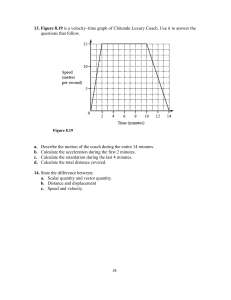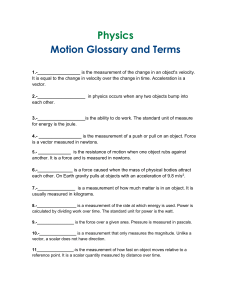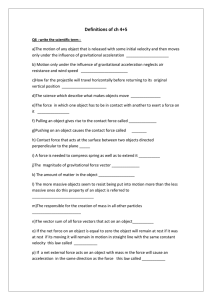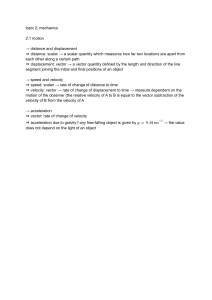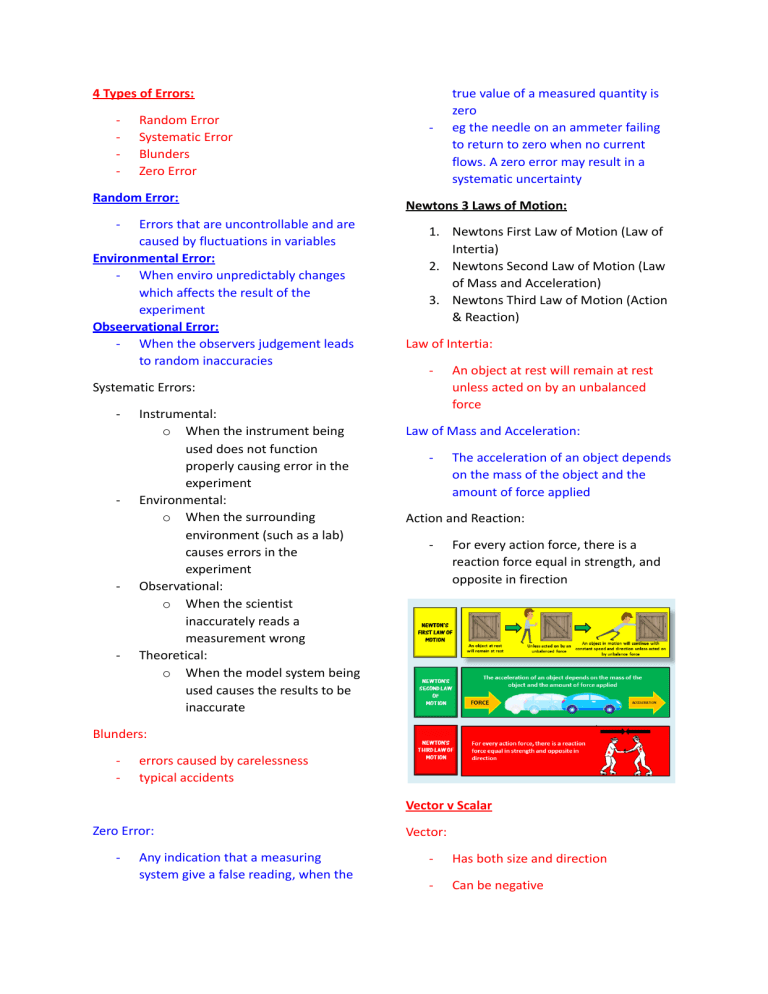
4 Types of Errors: - Random Error Systematic Error Blunders Zero Error Random Error: - Errors that are uncontrollable and are caused by fluctuations in variables Environmental Error: - When enviro unpredictably changes which affects the result of the experiment Obseervational Error: - When the observers judgement leads to random inaccuracies - Newtons 3 Laws of Motion: 1. Newtons First Law of Motion (Law of Intertia) 2. Newtons Second Law of Motion (Law of Mass and Acceleration) 3. Newtons Third Law of Motion (Action & Reaction) Law of Intertia: - Systematic Errors: - - - - Instrumental: o When the instrument being used does not function properly causing error in the experiment Environmental: o When the surrounding environment (such as a lab) causes errors in the experiment Observational: o When the scientist inaccurately reads a measurement wrong Theoretical: o When the model system being used causes the results to be inaccurate true value of a measured quantity is zero eg the needle on an ammeter failing to return to zero when no current flows. A zero error may result in a systematic uncertainty An object at rest will remain at rest unless acted on by an unbalanced force Law of Mass and Acceleration: - The acceleration of an object depends on the mass of the object and the amount of force applied Action and Reaction: - For every action force, there is a reaction force equal in strength, and opposite in firection Blunders: - errors caused by carelessness typical accidents Vector v Scalar Zero Error: - Any indication that a measuring system give a false reading, when the Vector: - Has both size and direction - Can be negative Scalar: 1. Gravity 2. Magnetic 3. Electric - Only has size - Can never be negative Acceleration: Distance / Displacement: - Distance = Scalar Displacement = Vector “s” or “x, d” SI unit: metre Time: - Vector “a” m/s^-2 - 𝑎𝑐𝑐𝑒𝑙𝑒𝑟𝑎𝑡𝑖𝑜𝑛 = - 𝑎= - u = Initial Veloicty Work / Energy / Heat: Scalar “m” Kilogram Power: - Speed / Velocity: - Speed = Scalar Velocity = Vector “v”, or “u” (initial velocity) 1 m/s or m s ^-1 - Average speed = 𝑑𝑖𝑠𝑡𝑎𝑛𝑐𝑒 𝑡𝑟𝑎𝑣𝑒𝑙𝑙𝑒𝑑 𝑡𝑖𝑚𝑒 𝑡𝑎𝑘𝑒𝑛 Force: - Vector “F” Newtons - can change the shape of an object, its size, its motion Force = Mass x acceleration - F=ma 3 Field Forces - Non Contact Forces Objects don’t have to touch each other to exert a force. Scalar “W “/ “E“/ “H” Joules - Scalar “P” Watt (W) 1 Watt = 1 Joule/Second Power is the rate (in seconds) at which work is done - Power = 𝑊𝑜𝑟𝑘 𝐷𝑜𝑛𝑒 /𝑇𝑖𝑚𝑒 𝑇𝑎𝑘𝑒𝑛 - Power = Energy Transfer/Time Taken Pressure: - Vector: “p” Pascals Torque / Moment: - 3 Types of Force 1) Push 2) Pull 3) Twist 𝑐ℎ𝑎𝑛𝑔𝑒 𝑖𝑛 𝑣𝑒𝑙𝑜𝑐𝑖𝑡𝑦 𝑡𝑖𝑚𝑒 𝑡𝑎𝑘𝑒𝑛 𝑣−𝑢 𝑡 Scalar “t” Seconds Mass: - - - - Vector τ = 𝐹𝑥𝑑 Turning effect of a force is called the moment (or torque) of the force Moment of a force (N m) = Force (N) x Perpendicular distance from the pivot (m) Newton Metre (N m) turning effect of force o Direction in where the force acts Mass and Weight: Momentum: - Vector P Newton Seccond law - Depends on its mass and its velocity - Measured in kg ms-1 or N s - 𝑚𝑎𝑠𝑠 𝑥 𝑣𝑒𝑙𝑜𝑐𝑖𝑡𝑦 (𝑘𝑔 𝑥 𝑚𝑠) - 𝑛𝑜 𝑣𝑒𝑙𝑜𝑐𝑖𝑡𝑦 = 𝑛𝑜 𝑚𝑜𝑚𝑒𝑛𝑡𝑢𝑚 Velocity: - Distance travelled in a unit time in a stated direction Vector Can be negative, since negative sign represents direction m s -1 If velocity is constant, resultant force = 0 - Average velocity = - 𝑣= - 𝑣 = 𝑢 + 𝑎𝑡 𝑡𝑜𝑡𝑎𝑙 𝑑𝑖𝑠𝑝𝑙𝑎𝑐𝑒𝑚𝑒𝑛𝑡 𝑡𝑖𝑚𝑒 𝑡𝑎𝑘𝑒𝑛 𝑠 𝑡 Distance moved in a stated direction Vector - Acceleration = - Symbol = “a” - 𝑎= - m s -2 vector Weight is the effect of a gravitational field on a mass Weight =Mass (kg) x gravitational field strength (N kg-1 often 9.81) 𝑤 = 𝑚𝑔 Is a force It is the effect of a gravitational field on a mass Weight is a force, and is measured in newtons Earths Gravitational Field: - Objects fall at the rate of 9.81m/s2 - On the Earth’s surface and mass of 1kg experiences a force of 9.81N - 𝑐ℎ𝑎𝑛𝑔𝑒 𝑖𝑛 𝑣𝑒𝑙𝑜𝑐𝑖𝑡𝑦 𝑡𝑖𝑚𝑒 𝑡𝑎𝑘𝑒𝑛 𝑣−𝑢 (𝑖𝑛𝑖𝑡𝑖𝑎𝑙) 𝑡 Force Diagrams: Show the forces acting on an object Each force is shown using a force arrow An arrow shows o The size of the force, longer the arrow, bigger the force Always use line of best fit unless asked otherwise Gradient = rise/run Displacement v time graph: - - - - - Acceleration - - Graphs: Displacement: - - Mass is the measure of the body's ability to resist changes in its acceleration Mass is measured in Kg Gradient = velocity Velocity v time graph: - gradient = acceleration Area = displacement Hookes Law: - F=kx F is the force applied to produce the extension or compression X (amount extended or compressed in m) - K tells us how stiff the spring is (how easy it is to stretch) in n/m Circular Motion: - - Objects travelling In a circular motion are prevented from moving off in a straight line by centripetal force A large force is needed if: o Speed is increased o Radius of circle has decreased o Mass of object has increased F = centripetal force m = mass of object v = velocity of object r = radius of circle - 𝐹= - - u = initial velocity v = final velocity a = constant value of acceleration t = time can take negative values 2 𝑚𝑣 𝑟 - Centre of Mass: - Is the point through which the mass of the object “appears to act” Resultant Vectors: - Found by drawing scale diagrams and measuring resultant Conditions of Equilibrium: - - Sum of all Forces equals zero o (or Resultant Force = 0 N) o If not, it is going to move with translational ( in a line) acceleration. Sum of all Moments equals zero o (or Resultant Torque = 0 Nm) o If not, it is going to rotate with angular (circle) SUVAT: Impulse: - Change in momentum caused by a force over time ∆𝑃 = 𝐹𝑛𝑒𝑡 𝑡 - Newton seconds Conservation of Momentum: - 𝑣=𝑢+𝑎𝑡 - 𝑠=𝑢𝑡+ - 𝑣 = 𝑢 + 2𝑎𝑠 - 𝑣𝑎𝑣𝑒𝑟𝑎𝑔𝑒 = - 𝑎𝑎𝑣𝑒𝑟𝑎𝑔𝑒 = - s = displacement 2 1 2 2 𝑎𝑡 - 2 Δ𝑠 𝑡 Δ𝑣 𝑡 - The total momentum of a system formed by any number of objects remains constant if there are no external forces acting on the system. When two or more bodies act on each other (collide, for example), their total momentum remains constant, - if there is no resultant external force acting. NB: The forces due to the collision between the bodies is NOT external, but internal (between them), therefore the momentum is conserved. 𝑝𝑠𝑦𝑠𝑡𝑒𝑚 𝑏𝑒𝑓𝑜𝑟𝑒 = 𝑝𝑠𝑦𝑠𝑡𝑒𝑚 𝑎𝑓𝑡𝑒𝑟 a. Gas, fuels 3. Gravitational energy o an object at a high position with a gravitational force on it has stored energy o 𝑚𝑎𝑠𝑠 𝑥 𝑔𝑟𝑎𝑣𝑖𝑡𝑦 𝑥 ℎ𝑒𝑖𝑔ℎ𝑡 o Output is joules Terminal Velocity: Conservation of Energy: Energy cannot be created or destroyed, but can be transferred from one form to another Mechanical Energy: - - - Measures an object's ability to do work Measures the sum the object's kinetic and potential energy. Mechanical energy is due to the position or movement of an object mechanical energy = kinetic energy + potential energy. Kinetic Theory: - Maximum velocity achieved by an object freely falling through a gas or liquid Achieved when resultant force = 0 Resultant Force: - −1 𝑚𝑠 - Overall force acting on an object −2 vs 𝑚𝑠 -1 is velocity -2 is acceleration Base Units: - Kinetic Energy: - 𝐾𝐸 = 1 2 2 𝑚𝑣 - energy of an object in motion if object is not moving = no kinetic energy 3 Potential Energy: 1. Elastic Energy a. Bows, springs 2. Chemical energy SI Units

